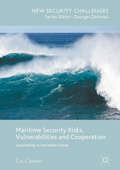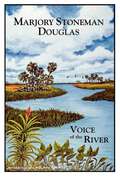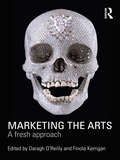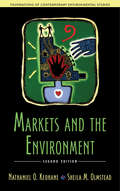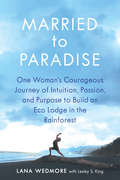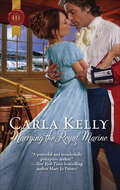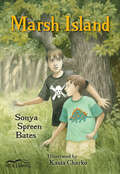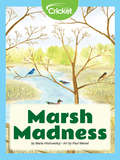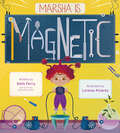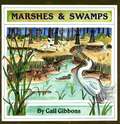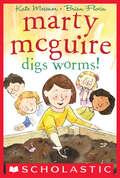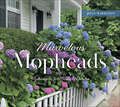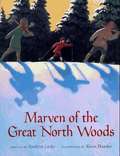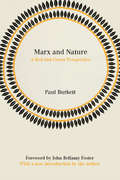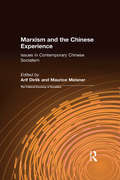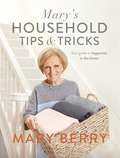- Table View
- List View
Maritime Salvage Operations and Environmental Protection (Routledge Research on the Law of the Sea)
by Durand Martin CupidoThis book questions the use of salvage law as legal regulatory framework for the remuneration of environmental services in salvage operations, proposing that such services should be based on direct contracting between commercial salvors and coastal States. Adopting an environment-first approach, it argues that direct contracting better serves and promotes environmental protection outcomes. It also takes a functional view of the law as a tool to promote values and sought outcomes. Salvage operations are recognised as the first line of defence against pollution following shipping incidents. Although regulated under the law of salvage, these operations form an integral component of a framework of environmental protection measures regulated under different legal instruments or laws. The law of salvage fails to effectively integrate salvage operations into broader pollution response mechanisms because it does not align comfortably with this framework of laws. Despite the emphasis on environmental protection in the 1989 London Salvage Convention, the Convention maintains the traditional notion of salvage operations as a service to property, while environmental outcomes and the remuneration of environmental services are positioned as a secondary outcome of the law of salvage. This book argues that directly contracting for environmental services bolsters the primacy of environmental protection and the functional use of law to further environmental protection and policy formulation. Direct contracting between coastal States and salvors for environmental services complements existing practices and pollution response mechanisms and provides a sound legal basis for the effective realisation of salvage operations as the first line of defence against pollution following shipping incidents without fundamentally altering the established commercial identity of the traditional law of salvage. This book will be key reading for students, academics, and practitioners working at the intersection of shipping and environmental law.
Maritime Security Risks, Vulnerabilities and Cooperation
by Lee CordnerThis book uniquely employs risk and vulnerability approaches to advocate international policy options for enhancing maritime security cooperation in the Indian Ocean region. Understanding shared risks and common vulnerabilities that impact the achievement of mutual objectives in the oceanic domain present practical bases for progressing collective action. The Indian Ocean sea lanes are the world's most important thoroughfares for energy resources (oil, gas and coal) and other cargoes. Secure maritime trade routes are vital to global, regional and national economies. Further, security challenges resulting from marine environmental degradation impacted by climate change are rising. Regional and extra-regional actors need to work more closely together to impose law and order at sea, control regional conflicts, respond to humanitarian crises and natural disasters, and conserve the marine environment. This book provides an invaluable resource for political leaders, policy advisers, academic researchers, military professionals, and students of international security and strategic studies.
Marjorie Harris Carr: Defender of Florida's Environment
by Peggy MacdonaldMarjorie Harris Carr (1915-1997) is best known for leading the fight against the U.S. Army Corps of Engineers’ Cross Florida Barge Canal. In this first full-length biography, Peggy Macdonald corrects many long-held misapprehensions about the self-described “housewife from Micanopy,” who struggled to balance career and family with her husband, Archie Carr, a pioneering conservation biologist.Born in Boston, Carr grew up in southwest Florida, exploring marshes and waterways and observing firsthand the impact of unchecked development on the state’s flora and fauna. Macdonald’s work depicts a determined woman and Phi Beta Kappa scholar who earned undergraduate and graduate degrees in zoology only to see her career thwarted by institutionalized gender discrimination. Carr launched her conservation career in the 1950s while raising five children and eventually became one of the century’s leading environmental activists.A series of ecological catastrophes in the 1960s placed Florida in the vanguard of the burgeoning environmental revolution as the nation’s developing eco-consciousness ushered in a wave of revolutionary legislation. With Carr serving as one of the most effective leaders of a powerful contingent of citizen activists who opposed dredging a canal across the state, “Free the Ocklawaha” became a rallying cry for environmentalists throughout the country.Marjorie Harris Carr is an intimate look at this remarkable woman who dedicated her life to conserving Florida’s wildlife and wild places. It is also a revelation of how the grassroots battle to save a small but vitally important river in central Florida transformed the modern environmental movement.
Marjory Stoneman Douglas: Voice of the River
by Marjory Stoneman DouglasBorn in Minnesota in 1890 and raised and educated in Massachusetts, Marjory Stoneman Douglas came to Florida in 1915 to work for her father, who had just started a newspaper called the Herald in a small town called Miami. In this "frontier" town, she recovered from a misjudged marriage, learned to write journalism and fiction and drama, took on the fight for feminism and racial justice and conservation long before those causes became popular, and embarked on a long and uncommonly successful voyage into self-understanding. Way before women did this sort of thing, she recognized her own need for solitude and independence, and built her own little house away from town in an area called Coconut Grove. She still lives there, as she has for over 40 years, with her books and cats and causes, emerging frequently to speak, still a powerful force in ecopolitics.Marjory Stoneman Douglas begins this story of her life by admitting that "the hardest thing is to tell the truth about oneself" and ends it stating her belief that "life should be lived so vividly and so intensely that thoughts of another life, or a longer life, are not necessary." The voice that emerges in between is a voice from the past and a voice from the future, a voice of conviction and common sense with a sense of humor, a voice so many audiences have heard over the years—tough words in a genteel accent emerging from a tiny woman in a floppy hat—which has truly become the voice of the river.
Marketing the Arts: A Fresh Approach
by Daragh O'Reilly Finola KerriganIn recent years, there have been significant shifts in arts marketing, both as a practice and an academic discipline. The relationship between art and the market is increasingly complex and dynamic, requiring a transformation in the way the arts are marketed. Marketing the Arts argues that arts marketing is not about the simple application of mainstream managerial marketing to the arts. With contributions from international scholars of marketing and consumer studies, this book engages directly with a range of contemporary themes, including: The importance of arts consumption and its social dimensions The importance of the aesthetic experience itself, and how to research it Arts policy development The art versus commerce debate The role of the arts marketer as market-maker The artist as brand or entrepreneur This exciting new book covers topics as diverse as Damien Hirst’s 'For the Love of God', Liverpool’s brand makeover, Manga scanlation, Gob Squad, Surrealism, Bluegrass music, Miles Davis and Andy Warhol, and is sure to enthuse students and enlighten practitioners.
Marketing the Wilderness: Outdoor Recreation, Indigenous Activism, and the Battle over Public Lands
by Joseph WhitsonHow outdoor industry marketing promotes an image of &“the wilderness&” as an unpeopled havenMarketing the Wilderness analyzes the relationship between the outdoor recreation industry, public lands in the United States, and Indigenous sovereignty and representation in recreational spaces. Combining social media analysis, digital ethnography, and historical research, Joseph Whitson offers nuanced insights into more than a century of the outdoor recreation industry&’s marketing strategies, unraveling its complicity in settler colonialism. Complicating the narrative of outdoor recreation as a universal good, Whitson introduces the concept of &“wildernessing&” to describe the physical, legal, and rhetorical production of pristine, empty lands that undergirds the outdoor recreation industry, a process that further disenfranchises Indigenous people from whom these lands were stolen. He demonstrates how companies such as Patagonia and REI align with the mining and drilling industries in their need to remove Indigenous peoples and histories from valuable lands. And he describes the ways Indigenous and decolonial activists are subverting and resisting corporate marketing strategies to introduce new narratives of place. Through the lens of environmental justice activism, Marketing the Wilderness reconsiders the ethics of recreational land use, advocating for engagement with issues of cultural representation and appropriation informed by Indigenous perspectives. As he discusses contemporary public land advocacy around places such as Bears Ears National Monument, Whitson focuses on the deeply fraught relationship between the outdoor recreation industry and Indigenous communities. Emphasizing the power of the corporate system and its treatment of land as a commodity under capitalism, he shows how these tensions shape the American idea of &“wilderness&” and what it means to fight for its preservation. Retail e-book files for this title are screen-reader friendly with images accompanied by short alt text and/or extended descriptions.
Markets and the Environment
by Nathaniel O. Keohane Sheila M. OlmsteadThis book provides a concise introduction to the economic theory of environmental policy and natural resource management. Like the other volumes in the series Foundations of Contemporary Environmental Studies, this book is a self-contained treatment of one aspect of the interaction between human society and the natural world.
Markets and the Environment, Second Edition (Foundations Contemporary Environmental)
by Dr Sheila M. Olmstead Mr Nathaniel O. KeohaneA clear grasp of economics is essential to understanding why environmental problems arise and how we can address them. So it is with good reason that Markets and the Environment has become a classic text in environmental studies since its first publication in 2007. Now thoroughly revised with updated information on current environmental policy and real-world examples of market-based instruments, the primer is more relevant than ever.The authors provide a concise yet thorough introduction to the economic theory of environmental policy and natural resource management. They begin with an overview of environmental economics before exploring topics including cost-benefit analysis, market failures and successes, and economic growth and sustainability.Readers of the first edition will notice new analysis of cost estimation as well as specific market instruments, including municipal water pricing and waste disposal. Particular attention is paid to behavioral economics and cap-and-trade programs for carbon.Throughout, Markets and the Environment is written in an accessible, student-friendly style. It includes study questions for each chapter, as well as clear figures and relatable text boxes. The authors have long understood the need for a book to bridge the gap between short articles on environmental economics and tomes filled with complex algebra. Markets and the Environment makes clear how economics influences policy, the world around us, and our own lives.
Married to Paradise: One Woman's Courageous Journey of Intuition, Passion, and Purpose to Build an Eco Lodge in the Rainforest
by Lana WedmoreThirty years ago, a young Colorado ski racer falls in love with the freedom and sensuality of a remote Costa Rican rainforest. However, unlike most of us who return home from our tropical vacations, she sets out to make this sensation her life, and to help others experience it. With her own hands, and the help of a Costa Rican boyfriend, she builds an ecolodge in the remote rainforest of Costa Rica's Osa Peninsula.During her journey, a tractor trailer rolls over on her, breaking her leg in four places, her house burns to the ground, and she completely runs out of money. These calamities only strengthen her resolve. In the end, she succeeds in building a lodge praised by media ranging from Travel + Leisure to CNN, and in helping people from all over the world experience one of the most biologically diverse places on earth. She also creates the nonprofit Whitehawk Foundation to save the Osa rainforest.
Marrying the Royal Marine
by Carla KellyA young woman’s journey to help in the war against Napoleon brings her close to a brave and caring officer in this historical romance.As the illegitimate daughter of a nobleman, Polly Brandon has always felt like an ugly duckling. So she’s amazed when Lieutenant Colonel Hugh Philippe Junot pays her such close attention as they sail for Portugal. She knows this Royal Marine would never look at her under ordinary circumstances, but having his protection is more than a comfort . . . it is a pleasure.Hugh is immediately taken with the spirited beauty aboard his ship. Her determination to assist with the war effort is admirable, and when she falls ill, he feels compelled to care for her. But Polly still has trouble believing what she sees in Hugh’s eyes—that she has turned from an ugly duckling into a desirable swan . . .
Marsh Island (Orca Echoes)
by Sonya Spreen BatesJake and his younger brother Tommy are on their first camping trip. While exploring in the woods on Marsh Island, they lose their way. When the boys start to feel like they're not the only ones wandering in the woods, they begin to wonder if the story their dad told them about old Alfred Marsh and his lost fortune is true.
Marsh Madness
by Maria HlohowskyjHave you ever gone birdwatching before? Learn about all the different birds that migrate to the Magee Marsh every spring! See all the kinds of birds that make their way to the same spot every year, like warblers, owls, and even ducks!
Marsha Is Magnetic
by Beth FerryIt turns out that the best way to "attract" friends to invite to your birthday is by being yourself in this sweet, STEAM-minded picture book from New York Times best-selling author Beth Ferry. Marsha's birthday is coming up, and she needs to make some friends to invite to her party. She's a little stumped...but a scientist knows how to solve problems: the scientific method! With equal parts creativity, determination, and humor, Marsha sets out to attract as many friends as she can for her birthday bash—what could possibly go wrong? In this hilarious celebration of birthdays, friendship, and ingenuity, Beth Ferry and Lorena Alvarez show readers that the best way to attract friends is to simply be yourself.
Marshes and Swamps
by Gail GibbonsMarshes and swamps are wetlands covering six percent of Earth's land area. They are a storage place for one of our most precious resources, water. They are also a defense against land erosion and home to many endangered plants and animals. Here is information about how marshes and swamps differ, their importance in the balance of nature, and the different kinds of life found in them. Fascinating facts about marshes and swamps are included.
Martin and the River
by Jon-Erik LappanoFaced with moving away from his beloved river in the country, Martin discovers it is possible to make a meaningful connection to nature in the city, too, and find ways to accept changes beyond his control. Martin loves to play by the river near his house. He watches the great blue herons and looks for crayfish and otters. He builds forts and lies in the tall grass near the water. But one day Martin’s parents tell him they have to move away, to the city. The family spend a day in the city, exploring their future home. Martin rides the subway, visits the market, explores the museum and watches a street performer, but none of the city’s charms can compare with the river. Then his parents show him a small stream running through the park, and Martin senses something familiar in the air. When moving day arrives, Martin fills a small glass jar with river water as a keepsake. And when he returns to the stream, he discovers that his connection to nature can be just as wondrous in the city. This poetic story looks at the special relationship between an imaginative child and the natural world, and explores how that connection can be nurtured and recreated in a new place. Key Text Features dialogue illustrations vignettes Correlates to the Common Core State Standards in English Language Arts: CCSS.ELA-LITERACY.RL.K.7 With prompting and support, describe the relationship between illustrations and the story in which they appear (e.g., what moment in a story an illustration depicts). CCSS.ELA-LITERACY.RL.1.2 Retell stories, including key details, and demonstrate understanding of their central message or lesson. CCSS.ELA-LITERACY.RL.1.4 Identify words and phrases in stories or poems that suggest feelings or appeal to the senses. CCSS.ELA-LITERACY.RL.1.7 Use illustrations and details in a story to describe its characters, setting, or events.
Marty McGuire Digs Worms!
by Brian Floca Kate MessnerAn irrepressible third grader’s school project to help the planet causes chaos instead in this funny, accessible chapter book.Marty McGuire’s third-grade class has a special assignment: Save the Earth! Even more exciting, the best project wins a special award. Marty’s pretty sure her classmates’ ideas won’t stand a chance against her plan to turn the garbage from the school cafeteria into fertilizer. All she needs is a little help from her teammate and best friend, Annie—and the worms in her grandma’s garden. But it turns out that worms are awfully SLOW eaters. And when the critters escape, the whole class starts grumbling. Can Marty save the Earth without losing her friends?Praise for Marty McGuire Digs Worms!“A quick, amusing read with an easily digestible environmental message; it is a perfect match for its young intended audience.” —Kirkus Reviews
Marvelous Cornelius
by Phil Bildner John ParraIn New Orleans, there lived a man who saw the streets as his calling, and he swept them clean. He danced up one avenue and down another and everyone danced along. The old ladies whistled and whirled. The old men hooted and hollered. The barbers, bead twirlers, and beignet bakers bounded behind that one-man parade. But then came the rising Mississippi--and a storm greater than anyone had seen before. In this heartwarming book about a real garbage man, Phil Bildner and John Parra tell the inspiring story of a humble man and the heroic difference he made in the aftermath of Hurricane Katrina.
Marvelous Cornelius: Hurricane Katrina and the Spirit of New Orleans
by Phil BildnerIn New Orleans, there lived a man who saw the streets as his calling, and he swept them clean. He danced up one avenue and down another and everyone danced along. The old ladies whistled and whirled. The old men hooted and hollered. The barbers, bead twirlers, and beignet bakers bounded behind that one-man parade. But then came the rising Mississippi—and a storm greater than anyone had seen before. In this heartwarming book about a real garbage man, Phil Bildner and John Parra tell the inspiring story of a humble man and the heroic difference he made in the aftermath of Hurricane Katrina. Plus, this is the fixed format version, which will look almost identical to the print version. Additionally for devices that support audio, this ebook includes a read-along setting.
Marvelous Mopheads: Hydrangeas for Home & Garden
by Joan HarrisonFinally, a book just about mopheads, the most-popular hydrangeas for home gardeners. A 2021 study by the University of Tennessee Extension Service estimates more than 10 million hydrangeas are sold in the US each year. Mopheads are far and away the hydrangeas in greatest demand, accounting for 90% of sales. New mophead varieties flood the market every year. It&’s hard to keep track of them all, let alone choose the perfect one(s) for the home garden. Marvelous Mopheads provides a comprehensive list of mophead varieties and invaluable advice about the best mopheads, including the older tried-and-true mopheads and more-recent introductions. The book is organized to present clear answers to frequently asked questions about • plant selection • color • pruning • indoor and outdoor placement • potting • feeding and fertilizing • soil pH adjustments • winter protection • care instructions • ensuring successful blooming With over 250 photos showing off the beauty of clearly labeled varieties, the book provides comprehensive information about the wonderful world of mophead hydrangeas.
Marvels & Mysteries of Our Animal World
by Reader'S DigestUnusual details of the known--and speculation about the unknown--lives and characteristics of more than 100 creatures that inhabit the earth. Explore the mysterious annual migration of the Monarch butterfly, read about the discovery of a fish thought to be extinct for millions of years, and find out so much more in this compilation of short easy-to-read articles from The Reader's Digest. An additional 200 animals, insects, fish and reptiles are briefly described in a special supplement that appears at the end of the book.
Marven of the Great North Woods
by Kathryn LaskyWhen the great influenza epidemic strikes Duluth, Minnesota, in 1918, Marven's parents know they must send their son far away to keep him safe from the disease. So the ten-year-old boards a train headed for a logging camp, not knowing if he will ever see his family again. In the great north woods, Marven finds a new world of towering trees, endless expanses of snow, and lumberjacks as big as grizzly bears. He feels very alone among the enormous woodsmen--until he meets Jean-Louis, the burliest jack of all, and they become fast friends.
Marxism and the Chinese Experience: Issues in Contemporary Chinese Socialism (Socialism And Social Movements Ser.)
by Arif Dirlik Maurice MeisnerThese essays consider the implications for Chinese socialism of the repudiation of the Cultural Revolution and the legacy of Mao Zedong as well as the meaning of the new definition and direction Mao's successors have given socialism. The themes have been selected for conceptual coherence within a socialist problematic of social change. Representing anthropology, art history, economics, history, literature and politics, various inquiries point in a twofold direction - the meaning of socialism for China and the meaning of Chinese Socialism for socialism as a global phenomenon - "meaning" not in some abstract sense but rather as it is constituted in the process of political ideological activity, which articulates and defines social relationships within China as well as China's relationship to the world.
Mary's Household Tips and Tricks: Your Guide to Happiness in the Home
by Mary BerryGet organised in 2022 with Mary Berry's essential household tips that will make home your true happy place'Practical AND beautiful' Graham Norton, BBC Radio 2________'This book is a collection of skills I've learned for running a home. Gleaned from years of practical experience, along with all the hints that friends and family have imparted to me, I hope it will be a helping hand' Mary BerryJoin national treasure Mary Berry in her comprehensive, beautifully illustrated guide that shares her greatest tips on how to care for your home. Inside you'll find . . . - KITCHEN KNOW-HOW: Love the heart of your home with freezer tips and how to organise your food- CLEANING & CONFIGURING YOUR HOME: Create cleaning products from store cupboard items- LAUNDRY & WARDROBE WISDOM: Banish moths from your home for good, remove stains from every kind of fabric- GARDENING & FLOWERS: Bring greenery into your home even without a garden, create beautiful flower arrangementsEasy to use, practical and gorgeously illustrated, Mary's Household Tips & Tricks covers everything from Mary's golden rules for baking to her favourite flowers for each season, from how to polish silver to whether tea should be poured before or after milk.With secrets for accomplishing the most challenging home-keeping tasks with ease, Mary's wonderfully simple book will help turn any house into a home.'The Queen of British baking has whipped up a recipe for home happiness' Independent'A domestic goddess' Daily Telegraph
Masculinities in Forests: Representations of Diversity (The Earthscan Forest Library)
by Carol J. ColferMasculinities in Forests: Representations of Diversity demonstrates the wide variability in ideas about, and practice of, masculinity in different forests, and how these relate to forest management. While forestry is widely considered a masculine domain, a significant portion of the literature on gender and development focuses on the role of women, not men. This book addresses this gap and also highlights how there are significant, demonstrable differences in masculinities from forest to forest. The book develops a simple conceptual framework for considering masculinities, one which both acknowledges the stability or enduring quality of masculinities, but also the significant masculinity-related options available to individual men within any given culture. The author draws on her own experiences, building on her long-term experience working globally in the conservation and development worlds, also observing masculinities among such professionals. The core of the book examines masculinities, based on long-term ethnographic research in the rural Pacific Northwest of the US; Long Segar, East Kalimantan; and Sitiung, West Sumatra, both in Indonesia. The author concludes by pulling together the various strands of masculine identities and discussing the implications of these various versions of masculinity for forest management. This book will be essential reading for students and scholars of forestry, gender studies and conservation and development, as well as practitioners and NGOs working in these fields.

